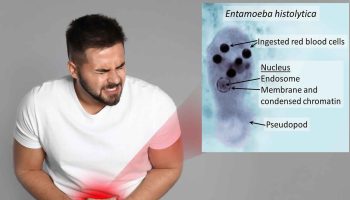Toxidrome
Toxidrome also known as toxic syndrome, is a group of signs and symptoms and/or characteristic effects for a group of toxic chemicals 1. Toxidromes are analogous to groups of symptoms associated with certain medical conditions. For example, a patient who is having an acute myocardial infarction (heart attack) will likely experience chest pain, nausea, shortness of breath, and/or diaphoresis. Similarly, if a patient presents with dilated pupils, confusion, agitation, flushed and dry skin, dry mouth, and tachycardia — all of which are symptoms associated with the anticholinergic toxidrome — healthcare providers should recognize that the patient may be experiencing toxicity caused by one or more substances that block cholinergic receptors in the body. Because seizures are another effect characteristic of the anticholinergic toxidrome, therapies such as administration of benzodiazepine medication to prevent the onset of seizures can be initiated while assessment and diagnostic evaluation studies are completed.
Toxidromes cannot be prevented completely since they are the manifestations or symptoms that are seen following exposure to a toxic substance or in response to an adverse reaction to or elevated level of medications, drugs, or substances. Toxidromes are not only seen in patients with poisonings or overdose exposures, but can develop in any patient receiving therapeutic doses of commonly prescribed medications as well. In addition, patients will continue to be exposed to substances that result in toxicity and onset of symptoms associated with the particular related toxidrome, whether intentionally or unintentionally.
A toxidrome may indicate a medical emergency requiring treatment at a poison control center. Aside from poisoning, a systemic infection may also lead to a toxidrome. Toxic syndrome or toxidrome recognition is important because it provides a tool for rapid detection of the suspected cause and can focus the differential diagnosis to consideration of only a few chemicals with similar toxic effects.
The major challenges nurses and other healthcare providers face in caring for critically ill patients with major toxidromes is being able to recognize that the patient has symptoms consistent with a toxidrome, and then being able to identify or differentiate which toxidrome the symptoms indicate.
Toxidromes often result from ingestion of overdose amounts or accumulation of medications with resultant elevated serum levels, but can also be seen as a result of adverse drug reactions and interactions between 2 or more medications. Thus, the ability to recognize those medications and/or combinations of medications that are most commonly associated with toxidromes for any of these reasons helps alert nurses to the potential that the patient is at risk of developing a toxicity-related syndrome.
This early detection is crucial in order to anticipate symptoms and effects rapidly, identify them when they do occur, and be prepared to initiate appropriate interventions as needed and without delay.
Common toxic syndromes or toxidromes noted below are derived from expected clinical effects after exposure to those chemicals most often reported to be involved in accidental spills, those with likelihood of causing significant health impact upon release, and those with emergent treatments available (eg, cyanide and nerve agent poisoning).
- Acute exposure to solvents, anesthetics, or sedatives toxidrome: Sedation with progressive central nervous system (CNS) depression leading to a decreased level of consciousness (progressing to coma in some cases), and minimal or no respiratory depression, and in some cases ataxia (difficulty balancing and walking), delirium, hallucinations, hypotension, bradycardia, nystagmus, hyporeflexia, decreased bowel sounds, miosis or mydriasis. Causative agents include: anticonvulsants, benzodiazepines, barbiturates, ethanol, methocarbamol, propoxyphene, trazodone, zolpidem, zaleplon and eszopiclone.
- Anticholinergic toxidrome: Under stimulation of cholinergic receptors leading to dilated pupils (mydriasis), decreased sweating, elevated temperature, and mental status changes, including characteristic hallucinations. Causative agents include diphenhydramine, antihistamines, atropine, antipsychotics, baclofen, phenothiazines, Jimson Weed, tricyclic antidepressants
- Anticoagulants toxidrome: Alteration of blood coagulation that results in abnormal bleeding indicated by excessive bruising, and bleeding from mucous membranes, the stomach, intestines, urinary bladder, and wounds, as well as other internal (e.g. intracranial, retroperitoneal) bleeding.
- Cholinergic toxidrome also called pesticide or nerve agent syndrome: Over stimulation of cholinergic receptors leading to first activation, and then fatigue of target organs, leading to pinpoint pupils (miosis), bradycardia, urination, bronchospasm, bronchorrhea, wheezing, muscle weakness, and muscle fasciculations, twitching, and excessive output from all secretory cells/organs (“leaking all over” – bronchial secretions, sweating, tears (lacrimation), salivation, vomiting, diarrhea/defecation, incontinence). Causative agents include: organophosphates, pilocarpine, carbamates and muscarinic mushrooms.
- Convulsant toxidrome: Central nervous system excitation (GABA antagonism and/or glutamate agonism and/or glycine antagonism) leading to generalized convulsions.
- Irritant or corrosive toxidrome: Immediate effects range from minor irritation of exposed skin, mucous membranes, pulmonary, and gastrointestinal (GI) tract to coughing, wheezing, respiratory distress and more severe gastrointestinal symptoms that may progress rapidly to systemic toxicity.
- Knockdown toxidrome: Disrupted cellular oxygen delivery to tissues may be caused by simple asphyxia due to oxygen displacement by inert gases, hemoglobinopathies (e.g. carbon monoxide, methemoglobin inducers) impairing oxygen transport by the red blood cell, and/or impairment of the cell’s ability to use oxygen (e.g. mitochondrial inhibitors such as cyanide). All of these situations lead to altered states of consciousness, progressing from fatigue and lightheadedness to seizures and/or coma, with cardiac signs and symptoms, including the possibility of cardiac arrest.
- Opioid toxidrome or narcotic toxidrome: Opioid agonism leading to pinpoint pupils (miosis), and central nervous system and respiratory depression, confusion, somnolence, coma, shallow respirations, bradypnea, bradycardia, hypotension, hypothermia, decreased bowel sounds and hyporeflexia. Causative agents include: clonidine, codeine, buprenorphine, dextromethorphan, heroin, methadone, morphine, meperidine, hydrocodone, oxycodone, imidazoline eye drops and tramadol.
- Stress-response or sympathomimetic toxidrome: Stress- or toxicant-induced catecholamine excess or central nervous system excitation leading to confusion, excessive speech, panic, excessive motor activity, tremor, insomnia, anorexia, diaphoresis, hyperreflexia, seizures, rhabdomyolysis, hyperactive bowel sounds and tachycardia (increased heart beat), respiration, and blood pressure. Causative agents include: amphetamines, methamphetamine, caffeine, cocaine, ephedrine, lysergic acid diethylamide (LSD) also known as acid, methylphenidate, nicotine and phencyclidine (PCP) also known as angel dust.
There are very few practice guidelines for treatment of toxidrome that can be applied to patients universally. Treatment recommendations should be based on the particular circumstances and specific characteristics associated with each individual patient and situation. For that reason, it is advisable to contact a poison control center for consultation with a toxicologist regarding important considerations and recommendations for treatment in specific patient situations.
Evidence-based interventions are available for treatment of many toxidromes, and research on additional interventions is ongoing. Administration of naloxone (Narcan) to reverse the CNS and respiratory depression associated with the opioid/narcotic toxidrome has been proven to be an effective intervention for several decades. In contrast, the use of intralipid/intravenous lipid emulsion therapy for treatment of the hypotension and bradycardia associated with beta blocker, calcium-channel blocker, and tricyclic antidepressant toxicity is relatively new; research into its effectiveness, side effects, and outcomes is ongoing.
Anticholinergic toxidrome
Anticholinergic toxidrome is common in the emergency department but rarely fatal 2. According to the 2015 annual American Association of Poison Control Centers report, there were just under 14,000 exposures reported to poison control centers that year, none of which were fatal 2. However, in prior years, up to 51 cases have been reported as fatal 3. The following year, there were 2,159,032 total cases of human exposure reported to poison control centers 4. Antihistamines were the sixth most frequently involved category of substances involved in human exposure at 4.19% 5. These figures probably grossly underestimate the total number of exposures as many go unreported to poison control centers 4.
Overdoses of compounds with anticholinergic activity can be accidental or intentional. Anticholinergics are readily accessible, and many medications have anticholinergic side-effects. Medications with anticholinergic properties are used in the treatment of motion sickness, nausea, insomnia, parkinsonism, and allergic reactions. Anticholinergic agents competitively inhibit acetylcholine at muscarinic receptors 4. They would be more accurately described as antimuscarinic agents as they only act on muscarinic receptors. Anticholinergics do not affect nicotinic receptors 4. Muscarinic acetylcholine receptors are located in smooth muscle, the ciliary body of the eye, salivary glands, sweat glands, and in the central nervous system (CNS). Muscarinic receptors are not found at the neuromuscular junction 6.
Most anticholinergic agents are orally ingested. The onset of action of orally ingested compounds is within 2 hours 7. The pharmacological actions of scopolamine can last for over 24 hours 8. The cardiovascular effects have been found to be of a much shorter duration than central nervous system (CNS) effects, which can last over 8 hours 9.
Anticholinergic toxidrome causes
Anticholinergic toxicity is typically secondary to an overdose of anticholinergic agents, although mild toxicity can be seen in the form of medication side effects. Substances with anticholinergic activity are used and misused extensively worldwide 4. The vast majority of these agents are orally ingested. The naturally occurring compounds atropine, hyoscyamine, and scopolamine are the prototypical anticholinergics from which others are synthesized. The prototypical anticholinergic agent atropine is used as an antidote for cholinergic toxicity from organophosphates and nerve agents 10. Atropine is also used as an acute treatment for bradyarrhythmias 11.
Other therapeutic uses of anticholinergics include antihistamines, antiparkinson drugs, sleep aids, antiemetics, and drugs for overactive bladder. Still, other medications have unrelated primary actions but also have anticholinergic side effects. These include tricyclic antidepressants, muscle relaxants, and antipsychotics. The effects of multiple anticholinergic medications are synergistic. This is especially important for elderly patients on multiple medications 12. The most common source of an anticholinergic drug overdose is antihistamines 2.
Plants are also a common source of accidental and intentional anticholinergic ingestion 13. Plants that contain belladonna alkaloids are often abused due to their hallucinogenic properties 14. Illicit drugs including cocaine and heroin have been known to be contaminated with anticholinergics such as scopolamine or atropine 15. Toxicity has been reported with topical application 16.
Anticholinergic toxidrome signs and symptoms
Signs and symptoms of anticholinergic toxidrome include:
- Dry mucous membranes,
- Flushed/dry/hot skin,
- Visual disturbances,
- Tachycardia,
- Urinary retention,
- Constipation,
- Seizures,
- Decreased bowel sounds.
A thorough history and physical exam are critical to the identification of patients with anticholinergic poisoning. Patients may present with a history of intentional ingestion of common anticholinergic agents such as antihistamines or jimson weed 13. Often, the history is less straightforward. Patients may present after a suicide attempt and be unwilling or unable to disclose what they ingested. Young children may be brought in by a caretaker/parent with somnolence or other anticholinergic symptoms although the ingestion may have been unwitnessed by the caretaker. Any history of potential co-ingestion should be obtained.
Due to potential difficulty in obtaining a reliable history, it is critical that the clinician be familiar with the anticholinergic toxidrome. The memory aid “red as a beet, dry as a bone, blind as a bat, mad as a hatter, hot as a hare, full as a flask” is helpful to remember the classic signs and symptoms of anticholinergic poisoning which include flushing, anhydrosis, dry mucous membranes, mydriasis, altered mental status, fever, and urinary retention. Decreased bowel sounds are also a common physical exam finding. CNS effects may include delirium, hallucinations, agitation, restlessness, confusion, staccato speech, and picking at clothing and bedding. Seizures and jerking movements are possible 17. Diphenhydramine, in particular, has been reported to be associated with wide-complex tachycardia and QT prolongation 18.
Anticholinergic toxidrome complications
- Respiratory failure
- Cardiovascular collapse
- Rhabdomyolysis
- Seizures
- Coma
- Permanent disability
- Death
Anticholinergic toxidrome treatment
Supportive care is usually all that is required for treatment of anticholinergic toxicity. However, physostigmine may be indicated in severe cases 19. Benzodiazepines should be administered for seizure activity. IV fluids should be administered in the case of hypotension or if rhabdomyolysis is suspected. Cooling measures should be initiated if significant hyperthermia is present 20. Activated charcoal should be considered if the ingestion was within one hour prior to presentation. However, administration somewhat outside this window may be appropriate, as anticholinergics decrease gastrointestinal motility 21. If wide-complex dysrhythmias develop, IV sodium bicarbonate should be administered 22.
Physostigmine is usually only given in the case of both peripheral and central signs and symptoms of anticholinergic poisoning 19. Physostigmine is an acetylcholinesterase inhibitor active in both the central and peripheral nervous systems. Resuscitation equipment including atropine should be readily available before physostigmine is given. The recommended dose is 0.5- to 2-mg IV for adults and 0.02 mg/kg IV for pediatric patients with a maximum pediatric dose of 0.5 mg 23. Repeat dosing may be required after approximately 30 minutes if symptoms recur 24. In general, physostigmine is only recommended in pure anticholinergic poisoning 25. Intravenous fat emulsion has been reported as a successful treatment for severe diphenhydramine overdose refractory to other interventions 26.
Anticholinergic toxidrome prognosis
Overall, with early identification and adequate supportive care, the prognosis of anticholinergic toxicity is good.
Cholinergic toxidrome
Cholinergic toxidrome is caused by medications, drugs, and substances that stimulate, enhance or mimic the neurotransmitter acetylcholine 27. Acetylcholine is the primary neurotransmitter of the parasympathetic nervous systems. Acetylcholine stimulates muscarinic and nicotinic receptors to cause muscle contraction and glandular secretions. Cholinergic toxicity occurs when too much acetylcholine is present in the receptor synapse leading to excessive parasympathetic effects. Cholinergic toxicity may occur with pesticides or medications, but most serious exposures are due to organophosphate or carbamate pesticide exposure 27. This poisoning kills about 200,000 people worldwide, especially in the Asia-Pacific region 27.
The underlying mechanism for cholinergic toxicity is excessive cholinergic receptor stimulation which can be caused by substances that mimic, stimulate, or enhance acetylcholine. The symptom complex produced by the agent depends on what type of receptor or combination of receptors is activated. There are three types of cholinergic receptor: central, muscarinic, and nicotinic. Excess acetylcholine at muscarinic receptors will result in symptoms increased secretions, bronchoconstriction, bradycardia, vomiting, and abdominal cramping. Excess acetylcholine at nicotinic receptors causes muscle fasciculations or paralysis due to activation of the neuromuscular junction. Acetylcholine excess in the central nervous system can cause confusion, headache, or drowsiness 28.
Acetylcholine accumulation at muscarinic receptors produces an increase in secretions which can manifest as bronchorrhea, salivation, tearing and sweating, bronchoconstriction, tightness in the chest, wheezing, bradycardia, vomiting, increased gastrointestinal motility, abdominal tightness, diarrhea, and cramps. Activation of muscarinic receptors in the eye by excess acetylcholine will produce miosis and blurry vision. Increased acetylcholine at nicotinic sites at the neuromuscular junction causes muscle fasciculations and a flaccid paralysis due to excess acetylcholine at the neuromuscular junction. Excess acetylcholine in the brain patients may cause headache, insomnia, giddiness, confusion, and drowsiness. More severe exposures may cause central depression resulting in slurred speech, convulsions, coma, and respiratory depression. Death can occur due to effects on the heart, respiration, and on the brain.
The correct diagnosis for cholinergic toxicity hinges on the ability to recognize the clinical picture and connect it with the history that would make this toxidrome possible. A thorough history and physical is critical in making this diagnosis. If the toxidrome is present, it is essential to try to identify the agent as the effects and length of toxicity vary by agent.
There are no specific laboratory or radiographic testing that will definitively make the diagnosis. Red blood cell acetylcholinesterase levels can be measured, but most hospital laboratories do not offer this test.
Treatment is aggressive supportive care, plus targeted therapy for cholinergic toxicity: atropine followed by an available oxime such as pralidoxime.
Decontamination and personal protective equipment must be used to prevent further absorption of the agent by the patient and harm to caregivers.
Cholinergic toxidrome causes
Cholinergic toxicity may result from insecticides, nerve agents, medications, and mushrooms. The most common cause of cholinergic toxicity worldwide is exposure to organophosphate and carbamate insecticides. Exposure to these insecticides may be through inhalation of vapors, ingestion, or direct contact of the chemical with the skin or mucous membrane. Organophosphates have been used worldwide for over 50 years as insecticides, though usage has decreased in the past 10 to 20 years. There are about 3000000 exposures to organophosphates or carbamates worldwide each year with approximately 200000 fatalities as a result of exposure 28. One million of these exposures were found to be unintentional, while the other 2 million exposures were secondary to suicidal attempts 29. The American Association of Poison Control Centers reported 86914 human exposures to pesticides in the United States in 1996 alone 30. Poisoning due to occupational exposure only accounted for one-fifth of the incidental contact, with a fatality rate of less than 1%. More than 90% of the non-occupational incidents were intentional with a fatality rate of exceeding 10%. Accidental exposure accounted for the other 10% with homicidal use less than 1%.
Sarin gas is a nerve gas typically seen in chemical warfare. Sarin gas was made originally in Germany in 1938 as a pesticide. It is well known for being involved in terrorist attacks in Japan in 1994 and 1995. Sarin is a well-known chemical warfare agent that continues to be a threat worldwide. Nerve agents have been used in subways by terrorist groups and by dictators to suppress communities within countries as well.
Cholinergic drugs may cause cholinergic crisis during clinical use or after an overdose. These drugs include drugs used to treat myasthenia gravis such as edrophonium and neostigmine, pilocarpine used for glaucoma, ipratropium, and Alzheimer drugs such as rivastigmine and donepezil. Essentially, any agent that creates an abundance of acetylcholine at the synapse may cause cholinergic toxicity. These drugs may cause weakness, but a cholinergic crisis is very rare with drugs taken at therapeutic doses.
Cholinergic toxidrome signs and symptoms
Cholinergic toxidrome signs and symptoms include:
- Bradycardia,
- Urination,
- Bronchospasm,
- Bronchorrhea,
- Lacrimation,
- Vomiting,
- Diarrhea/defecation,
- Miosis,
- Salivation,
- Sweating,
- Muscle weakness,
- Muscle fasciculations.
Physical exam findings depend on which receptors experience accumulation of acetylcholine.
Two helpful mnemonics to remember the muscarinic effects of excess acetylcholine are SLUDGE:
- S – Salivation
- L – Lacrimation
- U – Urinary frequency
- D – Diaphoresis/diarrhea
- G – Gastrointestinal cramping and pain
- E – Emesis
DUMBELS:
- D – Diarrhea/diaphoresis
- U – Urinary frequency
- M -Miosis
- B – Bronchospasm/bronchorrhea
- E – Emesis
- L – Lacrimation
- S- Salivation
Cholinergic toxidrome complications
Because cholinergic toxicity involves the parasympathetic nervous system, many severe complications can occur. Due to the severe bronchospasm and bronchorrhea, the respiratory system may fail and require assisted ventilation. Respiratory failure may also occur from the profound muscle weakness that can affect the muscles of the diaphragm. The cardiovascular system may collapse due to the profound bradycardia, hypotension, hypertension or arrhythmias, which can accelerate in a patient with known coronary artery disease, known chronic heart failure, or other cardiovascular diseases. These effects on the cardiovascular and respiratory systems may result in cardiopulmonary arrest and death. Electrolyte abnormalities may also result from excessive vomiting and diarrhea associated with cholinergic toxicity, putting the patient at risk of arrhythmias and death.
Cholinergic toxidrome treatment
Evaluation and management of every patient should begin with ABC’s (airway, breathing, circulation, disability, and exposure). Usual airway and circulatory support is necessary with two exceptions. During intubation, succinylcholine should not be used because the lack of acetylcholinesterase caused by the poisoning will cause prolonged paralysis. Aggressive decontamination is necessary. All clothing should be removed and discarded. The skin and eyes should be washed to avoid continued absorption of the agent. Healthcare workers should wear protective gear to prevent dermal and inhalation exposure to the agent.
Once suspected, treatment should consist of IV administration of atropine and pralidoxime. Atropine is given first, as pralidoxime may transiently worsen symptoms. Atropine acts as a direct antidote physiologically by antagonizing the muscarinic receptor’s actions of excessive acetylcholine such as bronchorrhea, bradycardia, salivation, and bronchoconstriction. Atropine can cross the blood-brain barrier and can help decrease the activity of centrally acting excess acetylcholine. The initial dose of IV atropine is 2 to 5 mg in adults and 0.05mk/kg in children every 5 minutes until pulmonary symptoms improve. Atropine must be titrated to alleviate bronchorrhea and bronchospasm; this may require large doses of atropine and treatment may continue for several days. The hospital pharmacy should receive advance notice that an extra atropine supply may be necessary.
Because atropine does not bind to nicotinic receptors, it does not treat neuromuscular dysfunction. Oximes such as pralidoxime have three actions that show benefit in acute cholinergic toxicity. Pralidoxime reactivates acetylcholinesterase, provides endogenous anticholinergic effects, and detoxifies unbound organophosphates. Oximes are used to work on the nicotinic neuromuscular junction and therefore should be given when there are signs of muscle weakness, especially if the weakness is occurring within the respiratory system 31. Most patients with organophosphate poisoning require treatment with an oxime; this is due to the variability of responses to oximes and the possibility of delayed toxicity. The FDA approved dosage of pralidoxime for organophosphate toxicity is 1 to 2 g infusion over 30 minutes which may be repeated in one hour is muscle weakness persists. A continuous infusion may also be necessary after the bolus dose. If available, obtain a toxicology or poison center consultation.
Seizures should receive therapy with benzodiazepines, not anti-epileptics. Prophylactic diazepam decreases neuropathological damage after organophosphate poisoning 32.
Cholinergic toxidrome prognosis
Medical management may be difficult in cholinergic toxicity, and thus the fatality rate is generally more than 15% 33.
- Toxic Syndromes/Toxidromes. https://chemm.nlm.nih.gov/toxicsyndromes.htm[↩]
- Mowry JB, Spyker DA, Brooks DE, Zimmerman A, Schauben JL. 2015 Annual Report of the American Association of Poison Control Centers’ National Poison Data System (NPDS): 33rd Annual Report. Clin Toxicol (Phila). 2016 Dec;54(10):924-1109.[↩][↩][↩]
- Watson WA, Litovitz TL, Klein-Schwartz W, Rodgers GC, Youniss J, Reid N, Rouse WG, Rembert RS, Borys D. 2003 annual report of the American Association of Poison Control Centers Toxic Exposure Surveillance System. Am J Emerg Med. 2004 Sep;22(5):335-404.[↩]
- Broderick ED, Khalil D, Crosby B. Anticholinergic Toxicity. [Updated 2019 Nov 11]. In: StatPearls [Internet]. Treasure Island (FL): StatPearls Publishing; 2019 Jan-. Available from: https://www.ncbi.nlm.nih.gov/books/NBK534798[↩][↩][↩][↩][↩]
- Gummin DD, Mowry JB, Spyker DA, Brooks DE, Fraser MO, Banner W. 2016 Annual Report of the American Association of Poison Control Centers’ National Poison Data System (NPDS): 34th Annual Report. Clin Toxicol (Phila). 2017 Dec;55(10):1072-1252.[↩]
- Mitchelson F. Muscarinic receptor agonists and antagonists: effects on ocular function. Handb Exp Pharmacol. 2012;(208):263-98.[↩]
- Scavone JM, Greenblatt DJ, Harmatz JS, Engelhardt N, Shader RI. Pharmacokinetics and pharmacodynamics of diphenhydramine 25 mg in young and elderly volunteers. J Clin Pharmacol. 1998 Jul;38(7):603-9.[↩]
- Renner UD, Oertel R, Kirch W. Pharmacokinetics and pharmacodynamics in clinical use of scopolamine. Ther Drug Monit. 2005 Oct;27(5):655-65.[↩]
- Ali-Melkkilä T, Kanto J, Iisalo E. Pharmacokinetics and related pharmacodynamics of anticholinergic drugs. Acta Anaesthesiol Scand. 1993 Oct;37(7):633-42.[↩]
- Geller RJ, Lopez GP, Cutler S, Lin D, Bachman GF, Gorman SE. Atropine availability as an antidote for nerve agent casualties: validated rapid reformulation of high-concentration atropine from bulk powder. Ann Emerg Med. 2003 Apr;41(4):453-6.[↩]
- Smulyan H. The Beat Goes On: The Story of Five Ageless Cardiac Drugs. Am. J. Med. Sci. 2018 Nov;356(5):441-450.[↩]
- Tune LE. Anticholinergic effects of medication in elderly patients. J Clin Psychiatry. 2001;62 Suppl 21:11-4.[↩]
- Vanderhoff BT, Mosser KH. Jimson weed toxicity: management of anticholinergic plant ingestion. Am Fam Physician. 1992 Aug;46(2):526-30.[↩][↩]
- Tiongson J, Salen P. Mass ingestion of Jimson Weed by eleven teenagers. Del Med J. 1998 Nov;70(11):471-6.[↩]
- Ridder WP, Klimek M, Rupreht J. [Physostigmine for the immediate treatment of a patient with the central anticholinergic syndrome induced by cocaine cut with atropine]. Ned Tijdschr Geneeskd. 2005 Jul 23;149(30):1701-3.[↩]
- Bernhardt DT. Topical diphenhydramine toxicity. Wis. Med. J. 1991 Aug;90(8):469-71.[↩]
- Holstege CP, Borek HA. Toxidromes. Crit Care Clin. 2012 Oct;28(4):479-98.[↩]
- Thakur AC, Aslam AK, Aslam AF, Vasavada BC, Sacchi TJ, Khan IA. QT interval prolongation in diphenhydramine toxicity. Int. J. Cardiol. 2005 Feb 15;98(2):341-3.[↩]
- Derinoz O, Emeksiz HC. Use of physostigmine for cyclopentolate overdose in an infant. Pediatrics. 2012 Sep;130(3):e703-5.[↩][↩]
- Bross MH, Nash BT, Carlton FB. Heat emergencies. Am Fam Physician. 1994 Aug;50(2):389-96, 398.[↩]
- Isbister GK, Kumar VV. Indications for single-dose activated charcoal administration in acute overdose. Curr Opin Crit Care. 2011 Aug;17(4):351-7.[↩]
- Sharma AN, Hexdall AH, Chang EK, Nelson LS, Hoffman RS. Diphenhydramine-induced wide complex dysrhythmia responds to treatment with sodium bicarbonate. Am J Emerg Med. 2003 May;21(3):212-5.[↩]
- Arens AM, Shah K, Al-Abri S, Olson KR, Kearney T. Safety and effectiveness of physostigmine: a 10-year retrospective review<sup/>. Clin Toxicol (Phila). 2018 Feb;56(2):101-107.[↩]
- Rosenbaum C, Bird SB. Timing and frequency of physostigmine redosing for antimuscarinic toxicity. J Med Toxicol. 2010 Dec;6(4):386-92.[↩]
- Pentel P, Peterson CD. Asystole complicating physostigmine treatment of tricyclic antidepressant overdose. Ann Emerg Med. 1980 Nov;9(11):588-90.[↩]
- Abdelmalek D, Schwarz ES, Sampson C, Halcomb SE, McCammon C, Arroyo-Plasencia A, Stenger A, Krehbiel N, Mullins ME. Life-threatening diphenhydramine toxicity presenting with seizures and a wide complex tachycardia improved with intravenous fat emulsion. Am J Ther. 2014 Nov-Dec;21(6):542-4.[↩]
- Lott EL, Jones EB. Cholinergic Toxicity. [Updated 2019 Jun 4]. In: StatPearls [Internet]. Treasure Island (FL): StatPearls Publishing; 2019 Jan-. Available from: https://www.ncbi.nlm.nih.gov/books/NBK539783[↩][↩][↩]
- Organophosphorus Insecticide Poisoning. EJIFCC. 1999 Jul;11(2):30-35.[↩][↩]
- Jeyaratnam J. Acute pesticide poisoning: a major global health problem. World Health Stat Q. 1990;43(3):139-44.[↩]
- Litovitz TL, Smilkstein M, Felberg L, Klein-Schwartz W, Berlin R, Morgan JL. 1996 annual report of the American Association of Poison Control Centers Toxic Exposure Surveillance System. Am J Emerg Med. 1997 Sep;15(5):447-500.[↩]
- Eyer P. The role of oximes in the management of organophosphorus pesticide poisoning. Toxicol Rev. 2003;22(3):165-90.[↩]
- Tuovinen K. Organophosphate-induced convulsions and prevention of neuropathological damages. Toxicology. 2004 Mar 01;196(1-2):31-9.[↩]
- Eddleston M, Buckley NA, Eyer P, Dawson AH. Management of acute organophosphorus pesticide poisoning. Lancet. 2008 Feb 16;371(9612):597-607.[↩]





